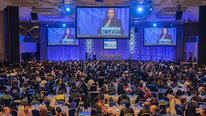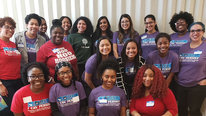- Ed Madison
- http://www.edmadison.com/
- Associate Professor
- Presenter’s NSFRESOURCECENTERS
- University of Oregon
- Ross Anderson
- Principal Researcher
- Presenter’s NSFRESOURCECENTERS
- Inflexion
- Niki DeRosia
- Doctoral Candidate; Graduate Research Fellow
- Presenter’s NSFRESOURCECENTERS
- University of Oregon
- Rachel Guldin
- Doctoral Candidate; Graduate Research Fellow
- Presenter’s NSFRESOURCECENTERS
- University of Oregon
- Jenefer Husman
- Department Head
- Presenter’s NSFRESOURCECENTERS
- University of Oregon
- Matthew Kim
- https://psychology.as.uky.edu/users/mki241
- Assistant Professor; Director of Developing Minds Lab
- Presenter’s NSFRESOURCECENTERS
- University of Kentucky
My STEM Story: Scaling Near-Peer STEM Mentoring Through Digital Storytelling
NSF Awards: 1759442
2021 (see original presentation & discussion)
Grades 9-12, Undergraduate, Graduate
My STEM Story is advancing efforts of the ITEST program to better understand and promote practices that increase student motivation and capacity to pursue STEM careers by developing and testing a novel approach to near-peer mentoring.
The project is based on the premise that filmed interactions between undergraduate students (near peers) and high school proteges with similar backgrounds and social experiences have potential to benefit high school students who view the videos within teacher-guided settings.
The project will examine the extent to which the planned creative and reflective video experiences generate interest in STEM pathways more effectively than traditional, academically focused approaches.
High school students filmed their conversations with undergraduate students about their academic struggles and successes in science, with the intention of bringing to life the experiences that students from underrepresented groups have in their pursuit of STEM careers.
In response to the pandemic, our research team received RAPID funding from NSF to create a fifth video module focused on the ways science careers can be in service to the public. The project was timely, as young people's exposure to public health research and outreach efforts by scientists and health care workers increased the visibility of STEM careers and their tangible impacts on the public.
*Some footage included in our STEM For All video entry was filmed prior to the pandemic. Any footage that was recorded after the pandemic was done so in accordance with safety measures required by the University of Oregon to conduct research activities.
Outcomes:
This digital storytelling approach is expected to promote positive attitudes toward science, interest in science disciplines, and intentions to pursue education pathways in science-related careers. In particular, it is anticipated that this approach will contribute to broadening the participation of students from groups historically under-represented in STEM-related education pathways and career domains.
Related Content for My STEM Story: Students Explore Science Identities
-
 2020My STEM Story
2020My STEM Story
Ed Madison
-
 2015Bridging the Gap
2015Bridging the Gap
Emily Stoeth
-
 2018iSTEM Transforming the Educational Landscape
2018iSTEM Transforming the Educational Landscape
Cynthia Trawick, EdD
-
 2019Computational Migration: Integrating Computing and Science
2019Computational Migration: Integrating Computing and Science
Colby Tofel-Grehl
-
 2019YouthAstroNet: STEM identity through authentic inquiry
2019YouthAstroNet: STEM identity through authentic inquiry
Mary Dussault
-
 2017Water SCIENCE
2017Water SCIENCE
Carolyn Staudt
-
 2021iSTEM-Xe: Implications of COVID-19 on the Black Community
2021iSTEM-Xe: Implications of COVID-19 on the Black Community
Shannon Jolly
-
 2021Internships for Underrepresented Students Amid the Pandemic
2021Internships for Underrepresented Students Amid the Pandemic
Lynda Gayden
Playlist: Broadening Participation in STEM by…
Broadening Participation in STEM by Focusing on Identity Development
-
 2022Advancing Science Identity in URM Emerging Researchers
2022Advancing Science Identity in URM Emerging Researchers
Iris Wagstaff
-
 2022Longitudinal Study of STEM Pathways
2022Longitudinal Study of STEM Pathways
Preeti Gupta
-
 2022Broadening Participation & Leadership in Freshwater Science
2022Broadening Participation & Leadership in Freshwater Science
Breanna Ondich
-
 2022Centering Women of Color in STEM: The ICP STEM Initiative
2022Centering Women of Color in STEM: The ICP STEM Initiative
Kerrie Wilkins-Yel
-
 2021Illuminating Career Pathways Through SEAS Islands Alliance
2021Illuminating Career Pathways Through SEAS Islands Alliance
Lisa Tossey
-
 2021My STEM Story: Students Explore Science Identities
2021My STEM Story: Students Explore Science Identities
Ed Madison
-
 2022Exploring geoscience careers to enhance STEM representation
2022Exploring geoscience careers to enhance STEM representation
Meagen Pollock






Marisol Santisteban
Great project! Near-peer mentoring is a great idea to develop that STEM identity. Were the HS students purely shadowing the college students, or were they also participating in a research project or other?
We find a similar issue among our minority students (have a high % of Native American, and also serve significant number of African American and hispanics). This year because the possibilities for F2F activities were diminished or absent, we are trying to compensate for the lack of role models by bringing former UNCP and former COMPASS student (our track1 S-STEM program) who are from underrepresented groups and working in various science fields as speakers in various panels (graduate school, industry jobs, conservation jobs, etc). Our COMPASS2 students report being very encouraged by these examples, many of them of very recent alumni, as we our COMPASS program ended only in 2019. These students were in their shoes only a few years ago and now they are scientists out there. You may imagine that our students found really exciting that one of our alumni works at Pfizer :). Initially we had planned to have a "retreat" style gathering where we would have brought former COMPASS students and the new COMPASS2 together but the pandemic derailed these plans.
Other interventions that aim to develop this science identity among our students is to have them participate in research projects, attend conferences (if only virtually this year), and we plan for them to present in the future.
In the flip model of yours, we are also planning for our undergraduates to help HS teachers at local schools and thereby they can serve as role models to the HS students and likely this will help them to picture themselves as scientists :)
Ed Madison
Ed Madison
Associate Professor
Thanks for your response. Yes, the high school students were actively engaged in the experiments. Glad to know about your work.
Ed Madison
Maria Santisteban
Mike Vargas
Physics Teacher
Hi Ed!
I too love this program. Mentorship is where it is at and I love the concept of neer - peer mentoring. My question is how do you guys see the teacher guided setting taking place? Would you walk me thru how a teacher would use this in their instruction?
Many Thanks
Mike
Ed Madison
Thomas Smith
Professor
I also like the near peer and Identity foci. I also really like how you engaged the students in shooting the videos. How are you planning on measuring your intended outcomes? And like Mike, I am interested in the role of the teacher. How necessary are they? I could imagine that "My STEM" story could be easier to scale, and potentially have broader impact, if it didn't need the teacher guidance.
Ed Madison
Ed Madison
Associate Professor
Hi Thomas, Luckily, our production took place the summer before COVID. We lent mentees cameras and facilitated a brief training session on "vlogging." Additionally, we enlisted and trained a team of our journalism school undergraduates to document the overall experiences. In terms of teacher roles... COVID has forced us to migrate our intervention into a self-guided online experience.
Ed Madison
Associate Professor
Thanks! COVID led us to migrate the next stage of our research from a classroom to an online experience, which will also allow the project to be scaled.
Ed Madison
Rebecca Vieyra
Doctoral Student
Hi there! I think near-peers is a great approach!
I am curious, however, about what you feel is most "replicable" from your work. The people and contexts in which they are mentoring/being mentored is clearly unique, but are there particular processes you think could be used at another site (i.e., recruitment of mentors and mentees, the support structures you have in place to guide mentors and mentees in their growth, or the way you assess changes in mentees' -- or even mentors' -- identities?)
Ed Madison
Ed Madison
Associate Professor
Hi Rebecca,
The level of logistics required was significant and costly, only made possible by the expertise and size of our grant-funded team. We will be publishing about the processes and support structures that made the project possible. and would make it "replicable."
James Callahan
Thank you Dr. Madison and the My STEM Story team!
Applause on the near-peer mentoring approach. It has been our experience, as well, that this is very effective. Bravo on your essential work.
Beautiful to have the mentors among those sharing the story.
Wonderful video!
Ed Madison
Ed Madison
Associate Professor
James,
Thank you!
Daniel Zietlow
Great project! The near-peer mentoring model looks really interesting and rewarding. Also, as a filmmaker, I was geeking out over the graphics in your video. As you transitioned to an online environment and spotlighting different individuals, have you all been providing storytelling or scicomm professional development for the students being spotlighted? If so, what has that looked like? Thanks!
Cheers, Dan
Ed Madison
Ed Madison
Associate Professor
Hi Daniel,
Thanks. My own professional documentary/television background trained me to interview individuals from all levels of expertise to break down complex terms and scientific jargon into digestible soundbites for novices. Also, in how to coach high school students to do the same when interviewing scientists.
Daniel Zietlow
Daniel Zietlow
Thanks for the insight!
Bree Barnett Dreyfuss
Great project! Have you made any of your students stories public online for potential incoming students that aren't local?
Ed Madison
Ed Madison
Associate Professor
Hi Bree,
We will when we're closer to the end of our study.
Alexander Rudolph
Hey Ed! Nice job highlighting your work with near-peer mentoring and storytelling as a means of increasing motivation among high school students. Do you have any results yet about whether the project has impacted the high school students in terms of their persistence into college STEM majors (or even into college at all). I am also curious if you have looked at how the project affects the near-peer mentors. Do they feel an increased sense of motivation as well?
Ed Madison
Associate Professor
Hi Alex,
Yes. Near-peer mentoring is mutually beneficial. Our mentors answered a series of exit questions and reported that they found the experience rewarding.
Tracey Sulak
We use a similar approach with younger students, but we are looking to expand to a high school model with near-peer mentoring. What training do you give the mentors and are the high school students already involved in advanced science courses? Also, any recruitment advice?
Martin Storksdieck
Greetings from Corvallis, Ed and team: what a cool project. Near-peer mentoring mostly focuses on the mentee. What did you find out about the mentors? How were they impacted?
Further posting is closed as the event has ended.